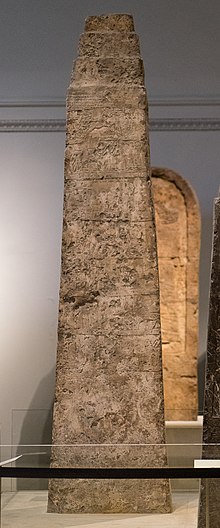
Nineveh, also known in early modern times as Kouyunjik, was an ancient Assyrian city of Upper Mesopotamia, located in the modern-day city of Mosul in northern Iraq. It is located on the eastern bank of the Tigris River and was the capital and largest city of the Neo-Assyrian Empire, as well as the largest city in the world for several decades. Today, it is a common name for the half of Mosul that lies on the eastern bank of the Tigris, and the country's Nineveh Governorate takes its name from it.

Shalmaneser III was king of the Neo-Assyrian Empire from the death of his father Ashurnasirpal II in 859 BC to his own death in 824 BC.
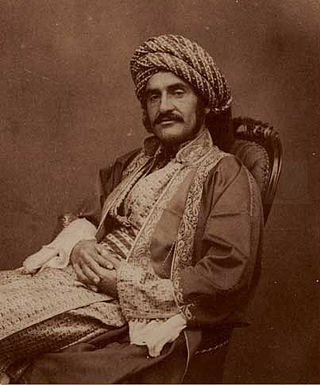
Hormuzd Rassam was an Assyriologist and author. He is known for making a number of important archaeological discoveries from 1877 to 1882, including the clay tablets that contained the Epic of Gilgamesh, the world's oldest notable literature. He is widely believed to be the first-known Middle Eastern and Assyrian archaeologist from the Ottoman empire. He emigrated to the United Kingdom, where he was naturalized as a British citizen, settling in Brighton. He represented the government as a diplomat, helping to free British diplomats from captivity in Ethiopia.

Shalmaneser V was the king of the Neo-Assyrian Empire from the death of his father Tiglath-Pileser III in 727 BC to his deposition and death in 722 BC. Though Shalmaneser V's brief reign is poorly known from contemporary sources, he remains known for the conquest of Samaria and the fall of the Kingdom of Israel, though the conclusion of that campaign is sometimes attributed to his successor, Sargon II, instead.

Nimrud is an ancient Assyrian city located in Iraq, 30 kilometres (20 mi) south of the city of Mosul, and 5 kilometres (3 mi) south of the village of Selamiyah, in the Nineveh Plains in Upper Mesopotamia. It was a major Assyrian city between approximately 1350 BC and 610 BC. The city is located in a strategic position 10 kilometres (6 mi) north of the point that the river Tigris meets its tributary the Great Zab. The city covered an area of 360 hectares. The ruins of the city were found within one kilometre (1,100 yd) of the modern-day Assyrian village of Noomanea in Nineveh Governorate, Iraq.
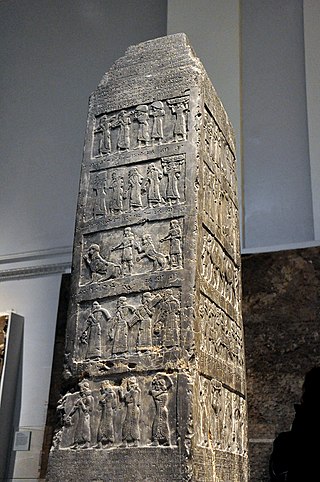
The Black Obelisk of Shalmaneser III is a black limestone Neo-Assyrian sculpture with many scenes in bas-relief and inscriptions. It comes from Nimrud, in northern Iraq, and commemorates the deeds of King Shalmaneser III. It is on display at the British Museum in London, and several other museums have cast replicas.

Ashur-nasir-pal II was king of Assyria from 883 to 859 BC. Ashurnasirpal II succeeded his father, Tukulti-Ninurta II. His son and successor was Shalmaneser III and his queen was Mullissu-mukannišat-Ninua.

Adad-nīrārī III was a King of Assyria from 811 to 783 BC. Note that this assumes that the longer version of the Assyrian Eponym List, which has an additional eponym for Adad-nīrārī III, is the correct one. For the shorter eponym list the ascension year would be 810 BC.
Kutha, Cuthah, Cuth or Cutha, modern Tell Ibrahim, is an archaeological site in Babil Governorate, Iraq. The site of Tell Uqair is just to the north. The city was occupied from the Old Akkadian period until the Hellenistic period. The city-god of Kutha was Meslamtaea, related to Nergal, and his temple there was named E-Meslam.
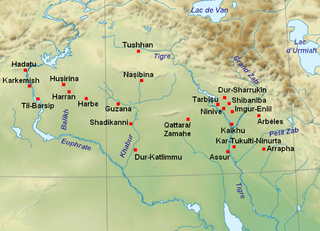
Balawat is an archaeological site of the ancient Assyrian city of Imgur-Enlil, and modern village in Nineveh Province (Iraq). It lies 25 kilometres (16 mi) southeast from the city of Mosul and 4 kilometres (2.5 mi) to the south of the modern Assyrian town of Bakhdida.

The Department of the Middle East, numbering some 330,000 works, forms a significant part of the collections of the British Museum, and the world's largest collection of Mesopotamian antiquities outside Iraq. The collections represent the civilisations of the ancient Near East and its adjacent areas.

The Neo-Assyrian Empire arose in the 10th century BC. Ashurnasirpal II is credited for utilizing sound strategy in his wars of conquest. While aiming to secure defensible frontiers, he would launch raids further inland against his opponents as a means of securing economic benefit, as he did when campaigning in the Levant. The result meant that the economic prosperity of the region would fuel the Assyrian war machine.
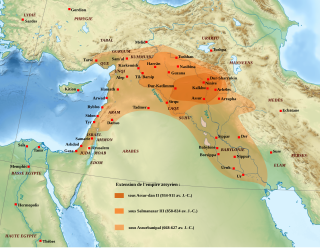
The Neo-Assyrian Empire was the fourth and penultimate stage of ancient Assyrian history. Beginning with the accession of Adad-nirari II in 911 BC, the Neo-Assyrian Empire grew to dominate the ancient Near East throughout much of the 8th and 7th centuries BC, becoming the largest empire in history up to that point. Because of its geopolitical dominance and ideology based in world domination, the Neo-Assyrian Empire is by many researchers regarded to have been the first world empire in history. It influenced other empires of the ancient world culturally, governmentally, and militarily, including the Babylonians, the Achaemenids, and the Seleucids. At its height, the empire was the strongest military power in the world and ruled over all of Mesopotamia, the Levant and Egypt, as well as parts of Anatolia, Arabia and modern-day Iran and Armenia.

The Balawat Gates are three sets of decorated bronze bands that had adorned the main doors of several buildings at Balawat, dating to the reigns of Ashurnasirpal II and Shalmaneser III. Their extensive use of narrative art depicting the exploits of Assyrian kings has cemented their position as some of the most important surviving works of art of the Neo-Assyrian Empire, comparable to the extensive Assyrian palace reliefs. When the Neo-Assyrian Empire fell in 614-612 BC, Balawat was destroyed. The wooden elements of the gates decomposed, leaving only the bronze bands. The remains of two sets of gates can be found in the British Museum's collection, those from the Temple of Mamu are housed in the Mosul Museum. Small sections of the Shalmaneser bronze door bands are also in the Louvre Museum at the Walters Art Museum in Baltimore and in the Istanbul Archaeology Museums.
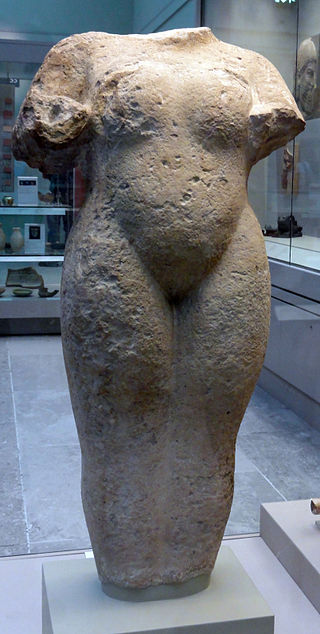
The Assyrian statue was originally set up near the temple of Ishtar in Nineveh. The statue remains the only known Assyrian statue of a naked woman. The inscription shows it was intended "for titillation" or "to be alluring", and may represent an attendant of Ishtar, or Ishtar herself in her role as the goddess of love. The statue was first dated by E. A. Wallis Budge as being c.1080 BCE.
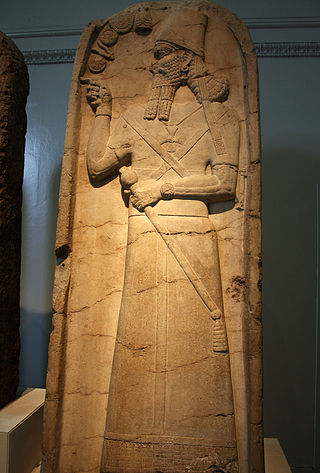
The Stela of Shamshi-Adad V is a large Assyrian monolith erected during the reign of Shamshi-Adad V. The stela was discovered in the mid nineteenth century at the ancient site of Kalhu by the British archaeologist Hormuzd Rassam. Dated to between 824-811 BC, the sculpture is now part of the British Museum's collection of Middle East antiquities.

The Sargonid dynasty was the final ruling dynasty of Assyria, ruling as kings of Assyria during the Neo-Assyrian Empire for just over a century from the ascent of Sargon II in 722 BC to the fall of Assyria in 609 BC. Although Assyria would ultimately fall during their rule, the Sargonid dynasty ruled the country during the apex of its power and Sargon II's three immediate successors Sennacherib, Esarhaddon and Ashurbanipal are generally regarded as three of the greatest Assyrian monarchs. Though the dynasty encompasses seven Assyrian kings, two vassal kings in Babylonia and numerous princes and princesses, the term Sargonids is sometimes used solely for Sennacherib, Esarhaddon and Ashurbanipal.

Assyrian sculpture is the sculpture of the ancient Assyrian states, especially the Neo-Assyrian Empire of 911 to 612 BC, which was centered around the city of Assur in Mesopotamia which at its height, ruled over all of Mesopotamia, the Levant and Egypt, as well as portions of Anatolia, Arabia and modern-day Iran and Armenia. It forms a phase of the art of Mesopotamia, differing in particular because of its much greater use of stone and gypsum alabaster for large sculpture.

The royal Lion Hunt of Ashurbanipal is shown on a famous group of Assyrian palace reliefs from the North Palace of Nineveh that are now displayed in room 10a of the British Museum. They are widely regarded as "the supreme masterpieces of Assyrian art". They show a formalized ritual "hunt" by King Ashurbanipal in an arena, where captured Asian lions were released from cages for the king to slaughter with arrows, spears, or his sword. They were made about 645–635 BC, and originally formed different sequences placed around the palace. They would probably originally have been painted, and formed part of a brightly coloured overall decor.

Sargon II ruled the Neo-Assyrian Empire from 722 to 705 BC as one of its most successful kings. In his final military campaign, Sargon was killed in battle in the south-eastern Anatolian region Tabal and the Assyrian army was unable to retrieve his body, which meant that he could not undergo the traditional royal Assyrian burial. In ancient Mesopotamia, not being buried was believed to condemn the dead to becoming a hungry and restless ghost for eternity. As a result, the Assyrians believed that Sargon must have committed some grave sin in order to suffer this fate. His son and successor Sennacherib, convinced of Sargon's sin, consequently spent much effort to distance himself from his father and to rid the empire from his work and imagery. Sennacherib's efforts led to Sargon only rarely being mentioned in later texts. When modern Assyriology took form in Western Europe in the 18th century, historians mainly followed the writings of classical Greco-Roman authors and the descriptions of Assyria in the Hebrew Bible for information. Given that Sargon is barely mentioned in either, he was consequently forgotten, the then prevalent historical reconstructions placing Sennacherib as the direct successor of Sargon's predecessor Shalmaneser V and identifying Sargon as an alternate name for one of the more well-known kings.
